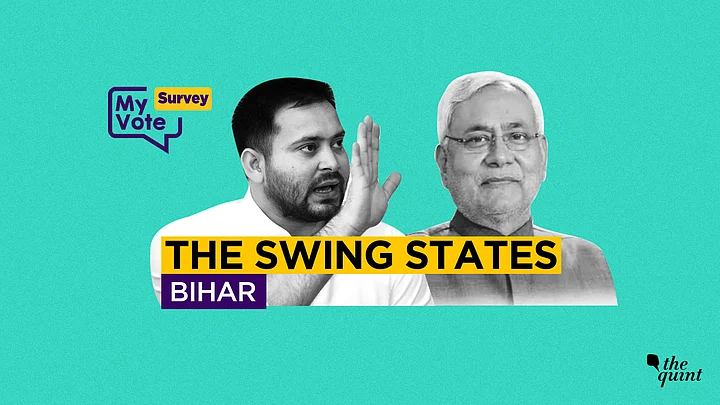After weeks of wrangling, the United Progressive Alliance announced its seat-sharing arrangement in Bihar for the Lok Sabha elections. Here's how Bihar's 40 Lok Sabha seats are being distributed among six alliance partners:
- RJD: 19
- Congress: 9
- RLSP: 5
- HAM(S): 3
- VIP: 3
- CPI(ML): 1
However, Bihar has become a nightmare for pollsters given the dynamic nature of alliances in the state.
Changing Alliances
In the 2014 elections, the Bharatiya Janata Party contested in alliance with Ram Vilas Paswan’s Lok Janshakti Party and Upendra Kushwaha’s Rashtriya Lok Samata Party, the Rashtriya Janata Dal fought along with the Congress and the Nationalist Congress Party and the Janata Dal (United) contested in alliance with the Left parties.
The BJP-led alliance won 31 out of 40 seats, the RJD-led alliance won seven seats and the JD(U) won two.
In the 2015 Assembly elections, the RJD, JD(U) and Congress formed a formidable Mahagathbandhan and swept to victory in the state. The BJP contested the polls in alliance with its 2014 partners LJP and RLSP and it was joined by a JD(U) splinter party Hindustan Awam Mocha (Secular) led by former chief minister Jitan Ram Manjhi.
Just to simplify the complicated nature of alliances in Bihar, let us look at how each of the parties stand individually.
In 2017, Nitish Kumar switched sides and turned the political equations in the state on their head.
In these elections, the contest is essentially between two alliances:
NDA: BJP, JD(U) and LJP
UPA: RJD, Congress, RLSP, HAM(S), VIP and CPI(ML)
The alliances also represent diverse social coalitions, with each party having a distinct support base:
In the NDA, the BJP has a strong base among Upper Castes, the JD(U) among Kurmis and non-Yadav OBCs and the LJP among Pasi Dalits.
In the UPA, the RJD has a committed support base of Muslims and Yadavs, the Congress has pockets of influence among Upper Castes, Muslims and Dalits, Upendra Kushwaha’s RLSP enjoys influence among OBC Koeris, Jitan Ram Manjhi’s HAM(S) among the Musahar community, Mukesh Sahani’s VIP among the Nishad/Mallah community and the CPI(ML) has the support of Dalits and OBCs in areas like Arrah.
NDA Ahead
Adding the votes of the current alliance partners in the 2014 and 2015 elections, the NDA had a sizeable lead.
If the survey by Poll Eyes is anything to go by, the NDA is still ahead in Bihar but its lead has shrunk considerably. In terms of vote share, the UPA is just three percent behind the NDA.
However, in terms of seats, the NDA is leading in 28 seats, against the UPA’s 12 according to the survey.
This is largely because the UPA has a larger lead in a smaller number of seats while the NDA is leading in a larger number of seats but with smaller margins.
However, smaller leads also make the NDA more susceptible to minor swings against it.
Seat-Wise View
According to the survey, the NDA has a decisive lead in only three seats, on the other hand the UPA has a decisive lead in six seats.
The remaining 31 seats are being closely contested between the two alliances. While the NDA has a slight lead in 13 of these seats, UPA has a slight lead in two. In 16 seats, the leads are too small to make a clear prediction.
In terms of regions, the NDA seems to be better placed in the north western part of the state – seats like Paschim Champaran, Purvi Champaran, Gopalganj and Valmiki Nagar – where the BJP has traditionally been strong.
The UPA is stronger in the Seemanchal region seats like Kishanganj and Katihar and also in north-central seats like Madhubani, Samastipur, Khagaria and Begusarai, while it is weaker in the western and southern parts of the state.
UPA Could Gain Ground
The survey was conducted a month ago, so it is possible that the UPA could gain ground by the time the polls are held due to the finalisation of the alliance as well as Congress President Rahul Gandhi’s promise of assured minimum income for the poorest of the poor. This could mean a shift of some votes toward the UPA.
Also, the vote share of a new outfit like Mukesh Sahani’s VIP is difficult to capture in a survey and this might also give UPA a slight advantage.
On the other hand, the UPA could be harmed by differences within the alliance, which had delayed the final seat-sharing announcement.
In Kishanganj, the UPA could find a spoiler in AIMIM candidate Akhtarul Iman, who has a sizable following in the area, particularly in the Kochadhaman Assembly segment.
In Begusarai, CPI candidate and former JNU students’ leader Kanhaiya Kumar could eat into the BJP’s Bhumihar votes as well as the anti-BJP votes of the RJD.
Sitting MP from Madhepura Pappu Yadav could harm the chances of the alliance candidate Sharad Yadav.
The eventual results would also depend on the UPA allies’ ability to coordinate and transfer votes effectively. Unless that happens, the NDA is likely to retain its advantage in the state.
(Survey methodology: The survey was conducted in February in all Assembly segments across 10 states. 50 respondents were interviewed at different locations in each Assembly segment, using random stratified sampling.)
Do read out other survey stories from Madhya Pradesh, Haryana, Jharkhand, Odisha and Gujarat.
(At The Quint, we question everything. Play an active role in shaping our journalism by becoming a member today.)
